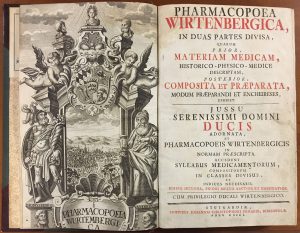
A pharmacopeia, in the modern sense, is a list of drugs and medicinal preparations, serving as an authoritative source of identification and a standard to be followed. Before the emergence of these works, however, medicines were described together with other treatments as part of general medical texts. Some were depicted in herbals and others in the materia medica books, with traditional medical remedies.
The first real pharmacopeia was, Pharmacorvm Omnivm, published by Valerius Cordus in 1546. Recognized as the official standard in Nurenberg, it inspired a chain reaction as many other European cities published their own local pharmacopeias. By the mid-17th century, this movement reached its peak, and the need to expand the jurisdiction of disparate pharmacopeias resurfaced. This eventually led to development of a standard for an entire country. The Pharmacopeia of the United States of America (Boston 1820) exemplifies this trend.
Publication of the Pharmacopœia Londinensis in 1618, a work widely disseminated in Europe through a multitude of foreign reprints, translations, and adaptations, illustrates another important aspect: authority. Backed by the Royal College of Physicians, the creation of this pharmacopeia was no longer one author’s responsibility. As time passed, institutional authority gradually shifted from societies (“colleges”) of physicians, to societies of pharmacists, or to governments responsible for producing national pharmacopeias.
The 18th century brought another important trend in the development of the modern pharmacopeia: an increased focus on scientific evidence. This was triggered by progress in the sciences, especially chemistry. It led to a reduction of listing remedies associated with superstitions or customs, and to greater interest in the testing of drugs. All of these changes happened slowly, and though the displacement started in the Age of Enlightenment, some traditional medicinal remedies persisted in pharmacopeias until the late 19th century.
Falk Library has original or facsimile editions of the texts mentioned above along with the beautifully preserved Pharmacopoea Wirtenbergica (Stuttgart 1750) pictured here. It served as a standard for the Duchy of Württemberg. This book is an example of a pharmacopeia combining a formulary and a textbook giving comprehensive information about the materia medica in addition to the required listings.
For more information or to view these volumes, e-mail techserv@pitt.edu or call 412-383-9773.
~Gosia Fort